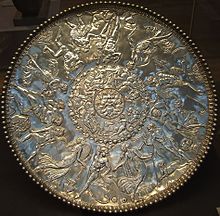
The Green Man is a term with a variety of connotations in folklore and related fields.
During the early modern period in England, and sometimes elsewhere, the figure of a man dressed in a foliage costume, and usually carrying a club, was a variant of the broader European motif of the Wild Man (also known as wild man of the woods, or woodwose). By at least the 16th century the term "green man" was used in England for a man who was covered in leaves, foliage including moss as part of a pageant, parade or ritual, who often was the whiffler (a person who clears a path or space through the crowd for a parade or performance). From the 17th century such figures were used for the names of pubs, and painted on their signs.[1]
In 1939, Julia Somerset, Lady Raglan, wrote an article in the journal Folklore that connected the foliate head artistic motif of medieval church architecture (which she also called the "Green Man") with other "green"-related concepts, such as the "Green Man" pubs, the Jack in the Green folk custom and May Day celebrations.[2] She proposed that the "Green Man" represented a pagan fertility figure. The idea has been contested by other folklorists, who assert that Lady Raglan had no evidence that the foliate head motif or other concepts she associated with it were pagan in nature.[3][4]
Lady Raglan's idea of the "Green Man" was adopted from the 1960s onward by the New Age and Neopagan movements,[3][4] and some authors have considered it to represent a Jungian archetype.[5] The nature of the Green Man as a mythological figure has been described as "20th-century folklore".[4]


- ^ Winick, Stephen (2021-02-17). "What Was the Green Man? | Folklife Today". The Library of Congress. Retrieved 2023-06-15.
- ^ Centerwall, Brandon S. (January 1997). "The Name of the Green Man". Folklore. 108 (1–2): 25–33. doi:10.1080/0015587X.1997.9715933. ISSN 0015-587X.
- ^ a b Livingstone, Josephine (2016-03-07). "The Remarkable Persistence of the Green Man". The New Yorker. Retrieved 2023-05-07.
- ^ a b c Olmstead, Molly (2023-04-08). "Is the Green Man British Enough for the Royal Coronation?". Slate. ISSN 1091-2339. Retrieved 2023-05-07.
- ^ Araneo, Phyllis. 2008. The Archetypal, Twenty First Century Resurrection of the Ancient Image of the Green Man. Journal of Futures Studies 13 (1): 43–64.